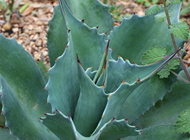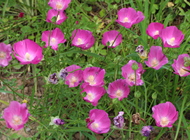 |
Garden journal entry |
 |
October 12, 2017. All our local nurseries specialize in tempting their customers with tropical fare and flare. It's so hot and humid nearly all of the year that those extravagant beauties from frost-free climates do great around here – except in years where the annual cold snap in January sends the thermometer to just slightly lower temperatures than usual (say, below 25F) for a little longer than usual (more than a few overnight hours). We had one of those more severe cold snaps this past winter (our first since moving to Houston), and sure enough, the lemon tree we had planted last year was toast (as were nearly all lemon trees in the general area), and many other of the flamboyant tropicals we had added suffered severe dieback – although most came back from the roots, they never reached the state of splendor displayed on the nursery tables last year that had prompted us to buy them in the first place.
So the overwhelming emphasis on tropicals (in which I count any plant rated no hardier than USDA zone 9 – our official zone here is 8b) is a mixed blessing at best. But it does provide an opportunity to get familiar with a whole host of plants I'd never before encountered. Two of those are shown here, in an interesting combination: the large-leaved plumeria, which we bought as a rooted stick in early spring, and the fine-textured duranta, purchased a little later in spring for its enchanting strands of deep purple-blue flowers. As hardiness goes, the plumeria is hopeless: it's hardy to only zone 10, so it will bite the dust in the first frost. I had hoped to see its elegant white flowers this year, but no such luck. Still, I'm happy to have had it in the garden this year: the large leaves held on fat fleshy stems make quite a statement, and I love the way the new leaves unfurl. Maybe I'll even try to make my own cutting in early winter, to keep a piece alive indoors, protected from the cold. The duranta stands a better chance of survival: it is hardy to zone 9, which means it can survive mild winters in our area. I'm hoping for a string of those, which might allow our specimen to grow into the small tree form that it can attain with time. I have no idea how likely it is for that scenario to play out. As with so many aspects of gardening in new circumstances, learning will come from experience – doing and observing in our own garden. No matter how much guidance I seek from local gardening sites or nursery personnel, I don't really believe it until I see for myself. |
Visitors to this page have left the following comments| Nancy B. | Dec 10, 2017 | I imagine it is a shock to go from gardening in PA to Houston's subtropical climate. It can be very frustrating gardening here!
I have several durantas around our yard. Since I like purple and gold leaf shrubs, I bought the gold leaf variety, Cuban Gold. (I use them with the hardier purple-leaf loropetalum var. rubrum, an outstanding shrub.) They may have other gold-leaf durantas out nowadays. However, they very rarely bloom. And don't withstand a freeze. (The recent snow and then frost the next morning nipped ours, but they are otherwise all right. We live in the SE area of Houston.) A hard freeze will kill to the ground - we cut them all the way back in late winter when we have had such a freeze, but, when the ground starts warming up, they come back. If you are in the north area of Houston, you will not be getting a small tree form of duranta. Once the wood on them dies in a freeze, that wood/stalk is dead. I do wish the gold leaf form bloomed the pretty blue flowers, but I do love the brilliant yellow/gold leaves. Even then, in the dead of summer, the leaves do green up some, as most gold-leaved plants do here with our long, hot growing season.
I have never tried to grow plumeria but on the FB page of Houston Gardening (a site you might consider joining), several people did and showed photos. I think, if I remember correctly, though, they kept theirs inside in winter and only brought them out when warm. It seemed some had them in pots and some had theirs bare-rooted.
Growing most citrus around here is always a toss up. That is one of the frustrating things about this climate. We will go several years w/o a real freeze and most everything tropical will do okay, and, then, Wham!, a polar event! And it's a mystery why some people's tropicals do fairly well and others in the same area don't, all things being equal. As far as tropicals go, the ones that require lots of water every day, I finally pulled out all of mine the summer my water bill started breaching $150-200 a month. Between the high water bills, health issues and being Plus-65, I replaced almost all my flower beds with shrubs. I just keep a few large containers with flowering plants anymore. It was a difficult decision as I had worked so hard and long to have good soil. I wish I had the strength I had ten years ago, hahah!
Over my lifetime, I have collected quite a few gardening books. Except for directions on soil prep and such matters, most of the information contained in them is useless for gardening in Houston - I just liked the photos and writings of the various authors. There are books on gardening specifically in Houston and/or the Gulf Coast. I have either gotten them or borrowed them from the library to read. I really prefer to borrow them from the library before deciding if it is a book I would use. My favorite gardening books is not a specific Texas / Gulf Coast book, but gave me terrific inspiration and guidance to gardening here. It is Sunbelt Gardening: Success in Hot-Weather Climates by Tom Peace. I don't know why but this book influenced me more than any other. I also see that Howard Garrett (The Dirt Doctor) has a Houston-specific book out - I will see if my library can get it for me!
Good luck with you gardening!
Nancy, thanks so much for sharing your experience and perspectives. I'm going to push the boundaries a bit before I settle for safe choices – wish me luck! |
|
|